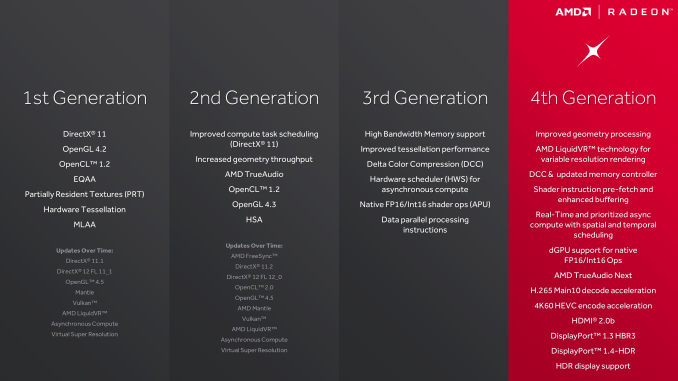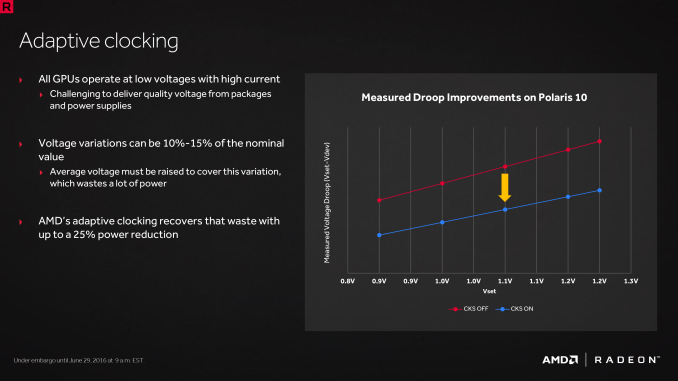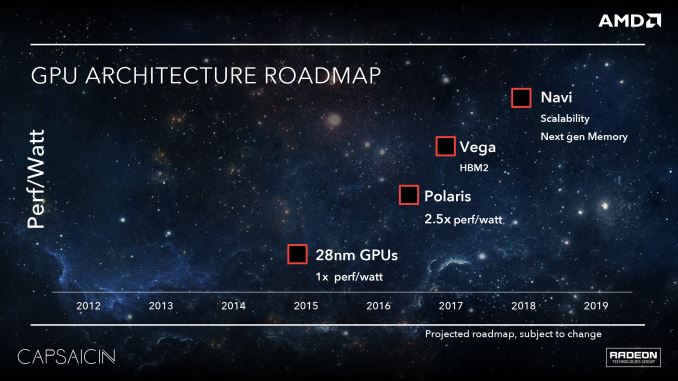The AMD Radeon RX 480 Preview: Polaris Makes Its Mainstream Mark
by Ryan Smith on June 29, 2016 9:00 AM ESTAMD's Path to Polaris
With the benefit of hindsight, I think in reflection that the 28nm generation started out better for AMD than it ended. The first Graphics Core Next card, Radeon HD 7970, had the advantage of launching more than a quarter before NVIDIA’s competing Kepler cards. And while AMD trailed in power efficiency from the start, at least for a time there they could compete for the top spot in the market with products such as the Radeon HD 7970 GHz Edition, before NVIDIA rolled out their largest Kepler GPUs.
However I think where things really went off of the rails for AMD was mid-cycle, in 2014, when NVIDIA unveiled the Maxwell architecture. Kepler was good, but Maxwell was great; NVIDIA further improved their architectural and energy efficiency (at times immensely so), and this put AMD on the back foot for the rest of the generation. AMD had performant parts from the bottom R7 360 right up to the top Fury X, but they were never in a position to catch Maxwell’s efficiency, a quality that proved to resonate with both reviewers and gamers.
The lessons of the 28nm generation were not lost on AMD. Graphics Core Next was a solid architecture and opened the door to AMD in a number of ways, but the Radeon brand does not exist in a vacuum, and it needs to compete with the more successful NVIDIA. At the same time AMD is nothing if not scrappy, and they can surprise us when we least expect it. But sometimes the only way to learn is the hard way, and for AMD I think the latter half of the 28nm generation was for the Radeon Technologies Group learning the hard way.
So what lessons did AMD learn for Polaris? First and foremost, power efficiency matters. It matters quite a lot in fact. Every vendor – be it AMD, Intel, or NVIDIA – will play up their strongest attributes. But power efficiency caught on with consumers, more so than any other “feature” in the 28nm generation. Though its importance in the desktop market is forum argument fodder to this day, power efficiency and overall performance are two sides of the same coin. There are practical limits for how much power can be dissipated in different card form factors, so the greater the efficiency, the greater the performance at a specific form factor. This aspect is even more important in the notebook space, where GPUs are at the mercy of limited cooling and there is a hard ceiling on heat dissipation.
As a result a significant amount of the work that has gone into Polaris has been into improving power efficiency. To be blunt, AMD has to be able to better compete with NVIDIA here, but AMD’s position is more nuanced than simply beating NVIDIA. AMD largely missed the boat on notebooks in the last generation, and they don’t want to repeat their mistakes. At the same time, starting now with an energy efficient architecture means that when they scale up and scale out with bigger and faster chips, they have a solid base to work from, and ultimately, more chances to achieve better performance.
The other lesson AMD learned for Polaris is that market share matters. This is not an end-user problem – AMD’s market share doesn’t change the performance or value of their cards – but we can’t talk about what led to Polaris without addressing it. AMD’s share of the consumer GPU market is about as low as it ever has been; this translates not only into weaker sales, but it undermines AMD’s position as a whole. Consumers are more likely to buy what’s safe, and OEMs aren’t much different, never mind the psychological aspects of the bandwagon effect.
Consequently, with Polaris AMD made the decision to start with the mainstream market and then work up from there, a significant departure from the traditional top-down GPU rollouts. This means developing chips like Polaris 10 and 11 first, targeting mainstream desktops and laptops, and letting the larger enthusiast class GPUs follow. The potential payoff for AMD here is that this is the opposite of what NVIDIA has done, and that means AMD gets to go after the high volume mainstream market first while NVIDIA builds down. Should everything go according to plan, then this gives AMD the opportunity to grow out their market share, and ultimately shore up their business.
As we dive into Polaris, its abilities, and its performance, it’s these two lessons we’ll see crop up time and time again, as these were some of the guiding lessons in Polaris’s design. AMD has taken the lessons of the 28nm generation to heart and have crafted a plan to move forward with the FinFET generation, charting a different, and hopefully more successful path.
Though with this talk of energy efficiency and mainstream GPUs, let’s be clear here: this isn’t AMD’s small die strategy reborn. AMD has already announced their Vega architecture, which will follow up on the work done by Polaris. Though not explicitly stated by AMD, it has been strongly hinted at that these are the higher performance chips that in past generations we’d see AMD launch with first, offering performance features such as HBM2. AMD will have to live with the fact that for the near future they have no shot at the performance crown – and the halo effect that comes with it – but with any luck, it will put AMD in a better position to strike at the high-end market once Vega’s time does come.













449 Comments
View All Comments
Yojimbo - Thursday, June 30, 2016 - link
What monopoly concerns? It's not illegal to have a monopoly, it's illegal to abuse a monopoly. other than that a monopoly position can affect regulatory rulings concerning mergers and acquisitions, but I doubt NVIDIA has any ambition to make a purchase of a GPU maker, so I doubt they would have any regulatory concerns. The important reason NVIDIA won't try to drive AMD out of the market is because they are interested primarily in increasing their profits and not with driving AMD out of the market. If NVIDIA can get 95% market share and maintain their profit margins they would be very happy, unconcerned with having "too much market share", providing they could achieve it without engaging in uncompetitive practices.cocochanel - Thursday, June 30, 2016 - link
I never knew Nvidia to be much concerned about monopolies. Over the years, my impression was that they only care about profit margins. And they are good at it.Yojimbo - Thursday, June 30, 2016 - link
Yes the RX 480 may have a cost advantage over the GTX 970, but the point is that AMD doesn't have the market completely to themselves since the RX 480's advantage over the GTX 970 is dubious. NVIDIA may have smaller profit margins in the space but it's not like they are uncompetitive in the space. The GTX 1060 will arrive soon enough to restore NVIDIA's profit margins. In the mean time inventories of the GTX 970 can be flushed out of the system for a profit.Questor - Wednesday, June 29, 2016 - link
"When can we get downvote buttons on AT comments?"I get your point, really I do! Be careful what you ask for. Heaven forbid you should say anything of merit over at TH. The foundations of civilization shake when you question a review(er) and the fanboys rules supreme with their mouse cursor over those little clickable arrows. You can say something that is completely true, accurate, responsible and even polite, but beware should you offend a minion! They and their brethren will pounce upon your words of wit and wisdom with the fury the scorned. Your post, feelings, opinions, facts, questions and whatever else you said, will be buried so deep, not even Hades will be able to dig it up!
JoeyJoJo123 - Wednesday, June 29, 2016 - link
You can go back to reddit and enjoy your inner-circle and upboat eachother to make yourselves feel good.Proper internet forums of speech aren't saddled by prominently displaying the most popular opinion. Everyone's post should be equally as worthless.
AntDX316 - Thursday, June 30, 2016 - link
How do you get a blue post?pashhtk27 - Thursday, June 30, 2016 - link
"Everyone's post should be equally as worthless."Nice. ;)
ddriver - Wednesday, June 29, 2016 - link
The rx480 is targeted in the market niche that has the best sales to profit margins ratio. It is about as fast as the gtx970, but is more efficient and better performing at new and upcoming games (vulkan, actual dx12 (not dumb ports)). In property optimized games (I mean not games nvidia pays to be left unoptimized for radeons) it is as fast as the r9 nano.I'd say job well done. A very efficient and well targeted launch. It would not be possible to do any better given amd's lack of resources, any higher expectations would be unrealistic and the product of genuine cluelessness or fanboyism.
smilingcrow - Wednesday, June 29, 2016 - link
More efficient by a negligible margin but it is good value; a Radeon Lidl 480. :)sonicmerlin - Friday, July 1, 2016 - link
Really? AMD advertised a 2.8x increase in performance per watt with Polaris. The card massively failed AMD's own expectations.